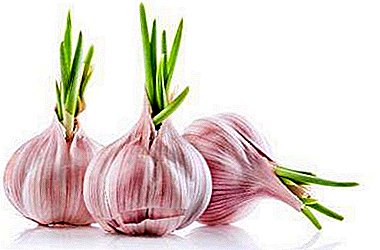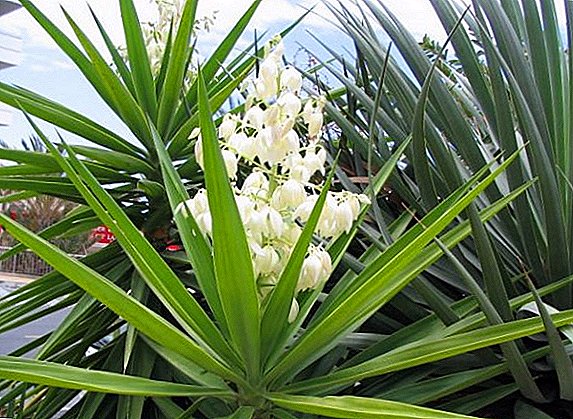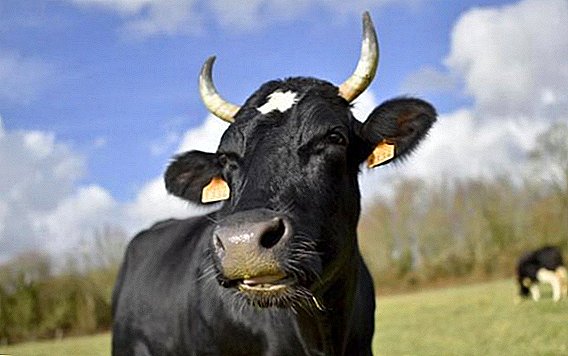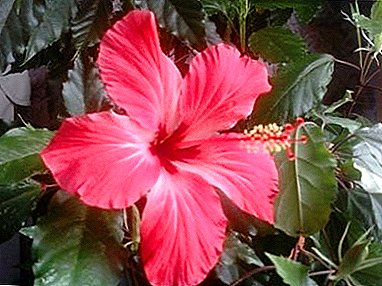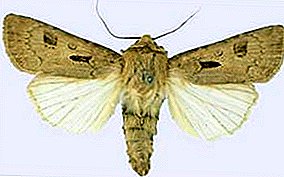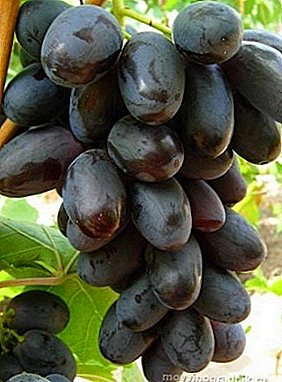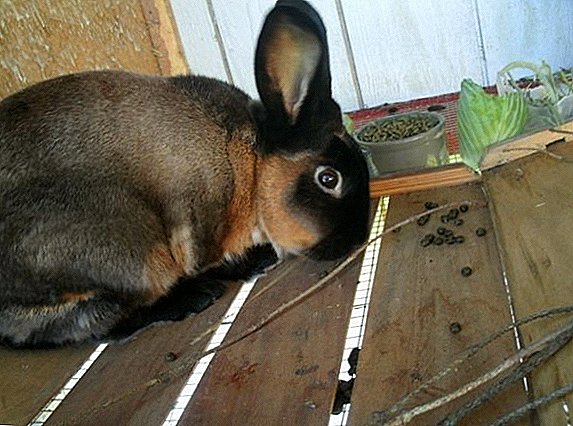
To date, parsley has become, if not an integral part of many dishes, then at least a very important part of them and a frequent guest on the dinner table.
Parsley can be bought in the store, but you can - which is much more tempting for some - to grow yourself. However, much, including taste, depends on the variety.
So which sort to choose? Perhaps the Italian Giant! We'll tell all the features of this plant, show, aaa, it looks in the photo and teach how to grow.
What is it?
"Italian Giant" - a popular mid-grade variety of smooth parsley foreign selection. It has a high yield, increased growth rate of foliage after cutting and a pleasant aroma.
Description and photo
The stem of the plant is dense. Stalk of medium length and medium thickness. The height of the bush can reach 30-60 cm. With one bush you can get 25 leaves.



Value
Italian Giant parsley is highly valued among gardeners. Basically, this plant is common due to high yield and quick recovery of the leaves after cutting.
Italian Giant grows well even in the shade, thanks to which it is very convenient to grow. In addition, parsley has a strong aroma, which also adds to this variety of attractiveness in the eyes of buyers.
Yield
As mentioned above, the Italian Giant parsley variety is valued for its high yield. With proper care from one square meter can be collected 2-5 kg of parsley.
The timing of seedlings
It grows this plant, like all spicy herbs, rather slowly. This is due to the large amount of essential oils contained in the seed coat. Usually the first shoots appear in fifteen to twenty days. If the soil is dry, seed germination may take 3-4 weeks.
This process can be accelerated if seeds are pre-grown. To do this:
- Soften the shell. For this, seeds are soaked in a thermos with hot water (45 ° C) and kept for at least 24 hours. Vodka can also be used instead of water (alcohol dissolves essential oils well). In vodka to withstand the seeds need about fifteen minutes.
- Next, the seeds are placed for 12 hours in a growth stimulator (“heteroauxin” or aloe juice). You can put the seeds in a light solution of potassium permanganate.
- Then the seeds spread on the gauze and give them to dry (so that they do not stick to the hands during sowing).
After this treatment, seedlings will appear within one week. If planting is planned for the winter, germinating seeds is not required. Until spring, they will have enough time to germinate in natural conditions. 60-75 days pass from germination to harvesting parsley.
Sowing
 You can start planting parsley in early spring. Due to the easy tolerance of frosts, this plant will be able to please you almost all year round. Many also plant parsley before winter to get an early harvest. Usually sowing is carried out in three terms:
You can start planting parsley in early spring. Due to the easy tolerance of frosts, this plant will be able to please you almost all year round. Many also plant parsley before winter to get an early harvest. Usually sowing is carried out in three terms:
- in early spring (end of April - beginning of May);
- in the middle of summer (late July);
- by winter (October-November).
However, the last word, of course, always remains with the gardener. Climate conditions also play an important role.
Resistance to diseases and parasites
The Italian Giant parsley variety is resistant to many diseases.. For example, it will easily transfer powdery mildew.
Weight
The roots of the Italian Giant parsley are not used for food, as this variety belongs to the leaf.
In parsley, the root part is unpresentable in appearance. (the roots are thin and hard) and uncomfortable for cooking. The mass of leaves that can be collected from one bush will be 75 g.
Bloom
Parsley is a biennial plant. In the first year of cultivation, it gives fragrant greens. And the Italian Giant blooms for the second growing season, in early summer. In June-July, blooms with small flowers of greenish-yellow color.
Frost resistance
Parsley "Italian Giant" has a good resistance to low temperatures. This variety will easily endure frosts down to -10 ° C.
Differences from other species
The “Italian Giant” is a bit different, but still different from its “brothers”. First, of course, the size of the bush. There are also differences in yield with m².
Breeding history
As well understood by name, this parsley variety is bred in Italy. This is an old variety that Italians consider the only truly genuine Italian parsley. In 2007 he was included in the State Register of breeding achievements.
Where to buy seed and how much will it cost?
 Italian Giant parsley seeds can be found in many stores, hypermarkets and specialized horticultural networks. In Moscow and St. Petersburg, this is the Auchan hypermarket chain and Leroy Merlin chain. In Moscow, you can also purchase parsley seeds at Beio or PlanetSad stores. In St. Petersburg, there are quite good stores of sowing materials “House of Seeds” and “SortSemOvosch”.
Italian Giant parsley seeds can be found in many stores, hypermarkets and specialized horticultural networks. In Moscow and St. Petersburg, this is the Auchan hypermarket chain and Leroy Merlin chain. In Moscow, you can also purchase parsley seeds at Beio or PlanetSad stores. In St. Petersburg, there are quite good stores of sowing materials “House of Seeds” and “SortSemOvosch”.
Some online stores sometimes make very profitable offers for the price of goods, and, for example, on “Ozone” or “SeedsPost” you can buy Italian Giant parsley seeds in gel pills, which will facilitate further cultivation of this plant. Prices for the seeds of the "Italian Giant" vary widely. They will have to pay for them from four to three hundred rubles - depending on the seller, the manufacturer’s company, the number of seeds per package.
Chemical composition
It's no secret that parsley is very healthy. But what is its value? One hundred grams of Italian Giant parsley accounts for:
- Calories: 49 kcal.
- Fat: 0.4 g
- Proteins: 3.7 g.
- Carbohydrates: 7.6 g.
- Water: 85 g
- Dietary fiber: 2.1 g.
- Organic acids: 0.1 g
- Starch: 0.1 g
- Mono - and disaccharides: 6.4 g
- Vitamins: A, B1, B2, B5, B6, B9, C, E, H, K, PP, Choline.
- Minerals:
- potassium - 800 mg;
- calcium - 245 mg;
- magnesium - 85 mg;
- sodium, 34 mg;
- phosphorus - 95 mg;
- iron - 1.9 g
Application
 Even in ancient Greece, our distant ancestors grew parsley, however, not for culinary delights, but for making ointments from poisonous insect bites. In Russia, too, for a long time, various parsley potions were prepared for the same purpose.
Even in ancient Greece, our distant ancestors grew parsley, however, not for culinary delights, but for making ointments from poisonous insect bites. In Russia, too, for a long time, various parsley potions were prepared for the same purpose.
Now parsley, in particular Italian Giant variety, used mainly for culinary recipes in dry or fresh form as a spice or as a decoration of ready meals.
Also, this plant is used for medicinal purposes. On parsley, many girls make natural face packs.
How to grow?
Growing this parsley variety will require some effort and patience.
Landing
Many gardeners to get young greens use the so-called conveyor method. This method consists in the constant sowing of new seeds. It is produced at intervals of 2-3 weeks. You can continue sowing until deep autumn, but this method is suitable only for leaf parsley.
The Italian Giant variety will grow better on light and humus-rich soils. The beds for planting are prepared in the fall, then organic and mineral fertilizers are added to the soil for digging. In the spring, potash phosphate fertilizers are added to the beds. Sometimes urea and ammonium nitrate are added. Parsley seeds are sown in early spring, in the middle of summer or in late autumn, before winter. When sowing, seeds are buried about one and a half centimeters. The distance between them should be 20 cm.
Plant Care
Parsley, as such, takes a bit. "Italian Giant" - the ten-resistant grade. It will grow well both in the sun and in the shade, and some believe that in the shade parsley grows more tender and fragrant.
What do you need to "Italian Giant" grew and pleased the gardener with delicious greenery? In principle, a bit. For this variety need infrequent watering, somewhere every 3-4 days. However, parsley is sensitive to soil moisture, because excessive moisture or, conversely, excessively dry soil is unacceptable.
Once a month the plant must be fed with a solution of superphosphates at the rate of 5 g per liter of boiled water. The best air temperature for parsley is 22-24 ° C, although the Italian Giant will be able to transfer frosts to minus ten degrees Celsius.
Harvesting
 Harvesting parsley is the easiest and most pleasant part of the whole growing process. However, there are some nuances.
Harvesting parsley is the easiest and most pleasant part of the whole growing process. However, there are some nuances.
- It is better to collect leaves from young shoots of the first year of planting. Their greens are much softer, tastier and more aromatic.
- Before you cut, it is worth checking the stem. It is better to take leaves from those sprouts where all three leaves have already ripened.
- Cut the leaves to the root. So in the future in their place will be more dense greens.
- Before winter, harvest the whole crop. After wintering, parsley leaves will no longer be suitable.
Protection against diseases and pests
In order to spend less time fighting diseases and parasites, it is worthwhile to take care of prevention in advance.
Such drugs as "Fitoverm" or "Iskra Bio", with periodic spraying of plants with them, will help from cicadas, or carrot fleas and flies. When a fungal disease, such as powdery mildew, rust, white spot, occurs, any copper-containing drug, such as copper sulfate or copper chlorine, or biologics, such as Fitosporin, will help.
The main carriers of fungal spores and parasites are weeds.. To reduce the risk of plant disease, keep the bed clean as much as possible.
Yes, for parsley will have to diligently care for, but it is worth it. This green has always been, is and will be a wonderful seasoning to many dishes. Rich in vitamins and healthy, and most importantly, also delicious, Italian Giant parsley can now always be on the dinner table.


